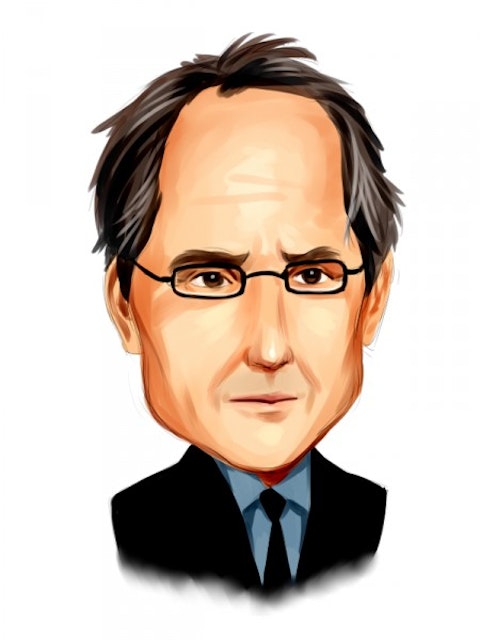Quantitative funds are gaining more ground among hedge funds in terms of trading volume and inflow of capital. According to The Wall Street Journal, this year, quantitative funds account for 27% of stock trading in the US, up from 14% in 2013. Moreover, as quant funds increased their stock trading volume, their peers in the hedge fund industry, as well as traditional asset management saw their volumes decline dramatically, although not as dramatically as banks, which accounted for just 3% of total stock trading this year, compared to 12.5%in 2013. Quant funds also have registered a steady increase in assets under management, which reached $920 billion in 2016, versus $510 billion in 2010, although non-quant funds also saw their AUM figures grow to $2.10 trillion from $1.41 trillion.
In addition, as stock market has had a solid bull run in the last couple of years, investors started to pull their money out of hedge funds, as they lagged the market and still charged their clients fees that some may deem exorbitant (hedge funds usually charge 2% of assets and 20% of returns). If in 2014, traditional hedge funds saw a net inflow of $58 billion from investors, the following year that figure declined to $27 billion, but in 2016 traditional hedge funds registered a net outflow of $83 billion. By comparison, quant hedge funds saw smaller inflows of $18 and $17 billion in 2014 and 2015, but they also had an inflow of $13 billion.
Quantitative hedge funds have also been showing better returns compared to some of their peers. According to Hedge Fund Research, the HFRX Quantitative Directional Index is 7.12% in the green year-to-date, slightly below the 8.85% return generated by the HFRX Equity Hedge Index. Over a longer period, quants show more steady returns with the HFRX EH: Quantitative Directional Index up by 4.54% in the last three years, compared to 1.91% for the Equity Hedge Index. Although the absolute leader among hedge funds are funds focused on technology and healthcare, with the HFRX EH: Technology/Healthcare Index up by 14.98% year-to-date and 9.20% in the green for the past 36 months.

Copyright: hin255 / 123RF Stock Photo
In this way, quantitative hedge funds, which rely on algorithms and computerized investing, have been becoming more popular and more hedge funds are starting to rely on technology in order to beat the market and analysts predict that it will be a crucial aspect of the hedge fund industry in the near future. In the meantime, a number of funds have already established themselves as industry leaders. The annual Hedge Fund 100 ranking compiled by Institutional Investor Alpha shows that five of the top six hedge funds of 2017 are quantitative hedge funds and on the following pages we are going to take a closer look at these funds.
Following quantitative hedge funds can be useful even if you don’t have the resources to invest in them. Hedge funds are mandated to reveal their long equity positions every quarter by submitting 13F filings with the Securities and Exchange Commission. Imitating hedge funds’ stock picks can help smaller investors beat the market over the long run. At Insider Monkey, we have developed a strategy that involves identifying the best small-cap stock picks among best performing hedge funds. Since it was launched in May 2014, the strategy returned over 67% and beat the S&P 500 ETF (SPY) by over 20 percentage points (see more details here).
Having said that, let’s take a look at the five best quant funds and their top five stock picks.
5. D. E. Shaw & Co.
D. E. Shaw & Co. is a quantitative hedge fund that manages around $27 billion in assets. In its latest 13F filing, D. E. Shaw disclosed an equity portfolio worth around $65.09 billion and highly diversified across both sectors and individual companies. At the end of September, D. E. Shaw’s top pick was Apple Inc. (NASDAQ:AAPL), in which the fund reported a $1.24 billion stake containing 8.02 million shares. Apple Inc (NASDAQ:AAPL) was followed by NXP Semiconductors NV (NASDAQ:NXPI) and Comcast Corporation (NASDAQ:CMCSA), with the fund holding 5.82 million shares worth $657.68 million and 15.28 million shares worth $587.85 million, respectively. Shaw’s top five picks are rounded off by TJX Companies Inc (NYSE:TJX), represented in the equity portfolio by a $574.85 million stake containing 7.79 million shares and Dell Technologies Inc (NYSE:DVMT), in which the fund owns 7.02 million shares valued at $542.26 million.

4. Two Sigma Advisors
Next in line is Two Sigma Advisors, founded by John Overdeck and David Siegel, former alumni at D. E. Shaw. Two Sigma Advisors manages around $38.97 billion in assets, having registered an increase of 28% over the last year. Two Sigma’s latest 13F filing showed an equity portfolio worth $35.28 billion, with Boeing Co (NYSE:BA), Amgen, Inc. (NASDAQ:AMGN), and Home Depot Inc (NYSE:HD) ranking as the top three picks. As of the end of September, Two Sigma holds 1.78 million shares of Boeing Co (NYSE:BA) (up by 33% over the quarter) valued at $451.59 million. The fund also disclosed a $404.35 million stake in Amgen, Inc. (NASDAQ:AMGN), which contains 2.17 million shares, and a $354.40 million stake in Home Depot Inc (NYSE:HD), which has 2.17 million shares. Pfizer Inc. (NYSE:PFE) and McDonald’s Corporation (NYSE:MCD) are also among Two Sigma Advisors’ top five picks, with the fund boosting its stake in Pfizer Inc. (NYSE:PFE) by over 220% to 9.87 million shares of Pfizer Inc. (NYSE:PFE) worth $352.54 million, while in McDonald’s Corporation (NYSE:MCD) the fund owns 2.02 million shares worth $317.03 million.

3. Renaissance Technologies
Jim Simons‘ Renaissance Technologies is also one of the best quant funds and is one of the most well-known. Renaissance has $42 billion in assets under management, up by 42% over the year. The top picks in Renaissance Technologies 13F portfolio include three healthcare companies: Humana Inc (NYSE:HUM), Gilead Sciences, Inc. (NASDAQ:GILD) and Amgen, Inc. (NASDAQ:AMGN). In Humana Inc (NYSE:HUM), Renaissance owns 3.66 million shares worth $891.71 million, while in Gilead Sciences, Inc. (NASDAQ:GILD) Renaissance’s stake contains 10.23 million shares worth $828.91 million. In Amgen, Inc. (NASDAQ:AMGN) Renaissance disclosed a $730.46 million position containing 3.92 million shares. Renaissance Technologies also owns 4.01 million shares of NVIDIA Corporation (NASDAQ:NVDA) worth $716.89 million and 2.68 million shares of NetEase Inc (ADR) (NASDAQ:NTES) valued at $707.82 million.

2. AQR Capital Management
Cliff Asness‘ AQR Capital Management saw its AUM surge by 48% to $69.7 billion in the last year. In its latest 13F filing, AQR disclosed an equity portfolio worth $83.80 billion. AQR Capital Management’s top pick is Apple Inc. (NASDAQ:AAPL), in which the fund owns 7.05 million shares valued at $1.09 billion. On the second spot is Microsoft Corporation (NASDAQ:MSFT), in which AQR’s position contains 13.39 million shares worth $997.39 million. Other top picks of AQR Capital Management include Gilead Sciences, Inc. (NASDAQ:GILD), Wal-Mart Stores Inc (NYSE:WMT), and Pfizer Inc. (NYSE:PFE). According to our calculations, AQR’s holdings in companies with a market cap over $1.0 billion returned 24% in the 12-month period ended June 30.

1. Bridgewater Associates
On the top spot is Bridgewater Associates, which has $122 billion in hedge fund assets as of the beginning of 2017, up by 17% on the year. The fund, managed by Ray Dalio gained 10% in the 12-month period ended June 30 based on the weighted average return of its long positions in companies valued above $1.0 billion and disclosed in 13F filings. Bridgewater’s 18 largest holdings are in ETFs and Kroger Co (NYSE:KR) is the top non-ETF position, which contains 2.11 million shares worth $42.31 million. Other top stock picks of Bridgewater Associates include Express Scripts Holding Company (NASDAQ:ESRX), Macy’s Inc (NYSE:M), Bed Bath & Beyond Inc. (NASDAQ:BBBY), and Alliance Data Systems Corporation (NYSE:ADS).






